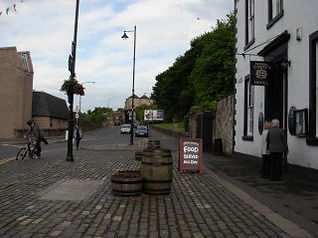
St Magdalene Linlithgow


The Town.
Linlithgow is located in the north-east of West Lothian, close to the border with Stirlingshire. It lies 20 miles (30 km) west of Edinburgh along the main railway route to Glasgow. Before the construction of the M8 & M9 motorways and the opening of the Forth Road Bridge, the town lay on the main road from Edinburgh to Stirling, Perth and Inverness while the canal system linked the burgh to Edinburgh and Glasgow. The nearby village of Blackness once served as the burgh's port. Linlithgow is overlooked by its local hill, Cockleroi.
The chief historic attraction of Linlithgow is the remains of Linlithgow Palace, the birthplace of James V and Mary, Queen of Scots, and probably Scotland's finest surviving late medieval secular building. The present Palace was started (on an older site) in 1424 by James I of Scotland. It was burnt in 1746, and, whilst unroofed, it is still largely complete in terms of its apartments (though very few of the original furnishings survived).
Linlithgow was also the site of the Battle of Linlithgow Bridge at the western edge of the town. The bridge no longer stands. The roadway to Linlithgow over the River Avon is described by scholars as a lifted road.
Besides the Palace, a second attraction, standing adjacent, is 15th century St. Michael's Church. Its western tower originally had a distinctive stone crown spire, of the type seen also on St Giles Cathedral in Edinburgh, or Newcastle Cathedral, but it was removed in the early 19th century. In 1964 a replacement and controversial spire in aluminium in a modern style by Scots architect Sir Basil Spence (Clarification needed: Credited elsewhere to sculptor Geoffrey Clarke), representing Christ's crown of thorns, was added.
Many historic buildings line the High Street. On the south side ground levels rise and several historic "wynds" and "closes" as found in Edinburgh still exist. The most prominent space is on axis with the road to the Palace. This contains the Cross Well of 1807 (redesigned by James Haldane which proclaims itself to be a replica of its 1628 predecessor. To its north stands the Town House of 1668 by the master mason John Smith. This replaced a previous hall demolished by Oliver Cromwell's army in 1650. Much of it´s original interior was removed in a modernisation project of 1962. The High Street is particularly noted for it´s high number of ancient taverns.
Pubs you don`t want miss out in Linlithgow:
Hotel:

The Story and Legend of The Black Bitch
Twas off the bonnie banks of Linlithgow Loch, some 350 years ago, the king had sentenced a thief to starve to death ordering him chained to an oak tree on a floating islet. The captive’s faithful companion, a black greyhound, treaded through icy waters with food in her mouth attempting to save her master’s life. When the palace caught onto the canine’s caper she was shackled to a different tree on a nearby islet leaving both prisoner and pooch to perish. From that day forward the townspeople of Linlithgow were so touched by the dog’s loyalty that they started referring to themselves as “black bitches.”

